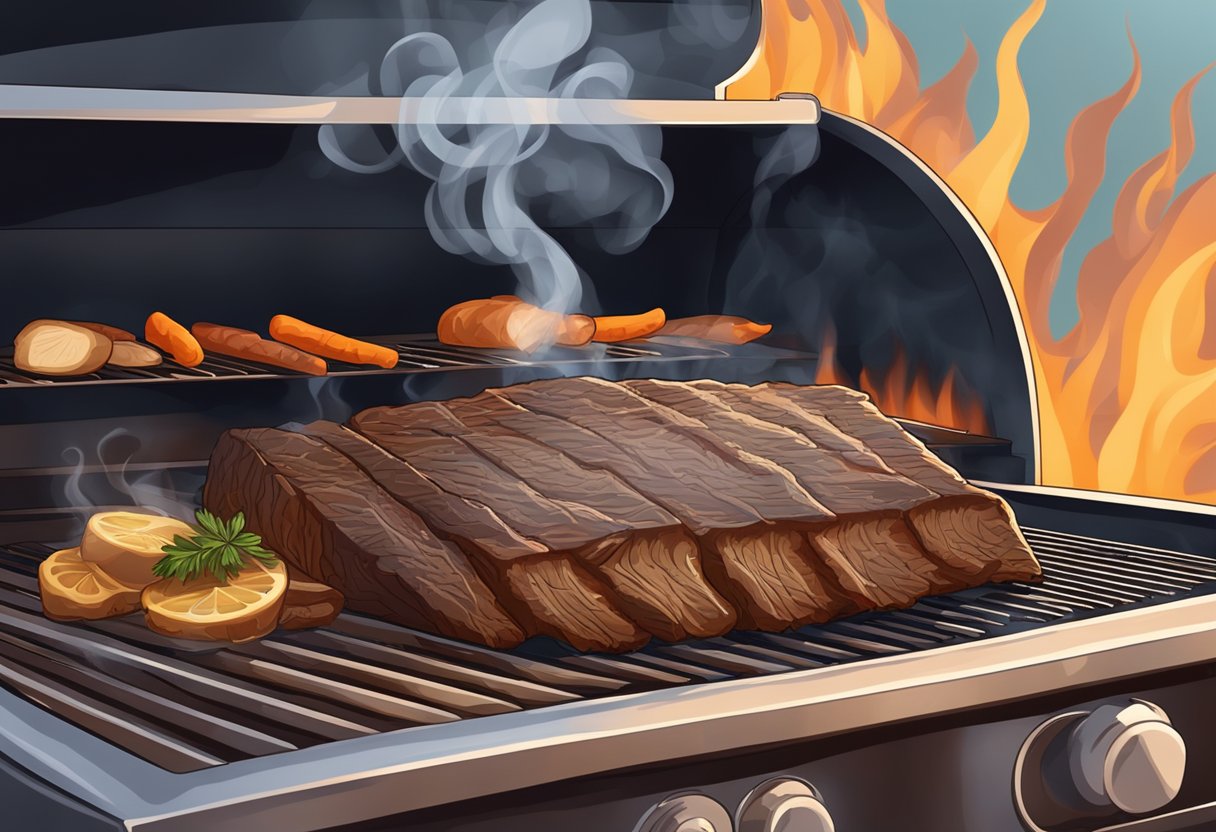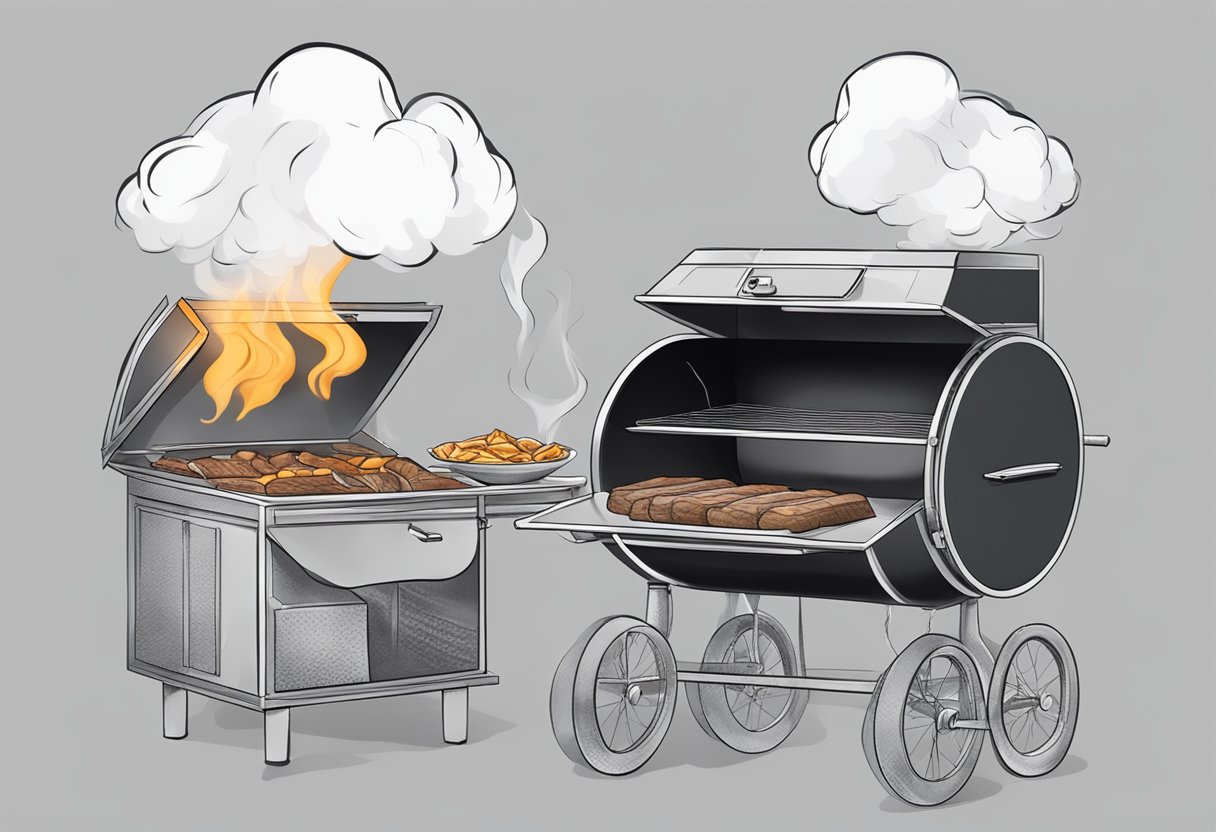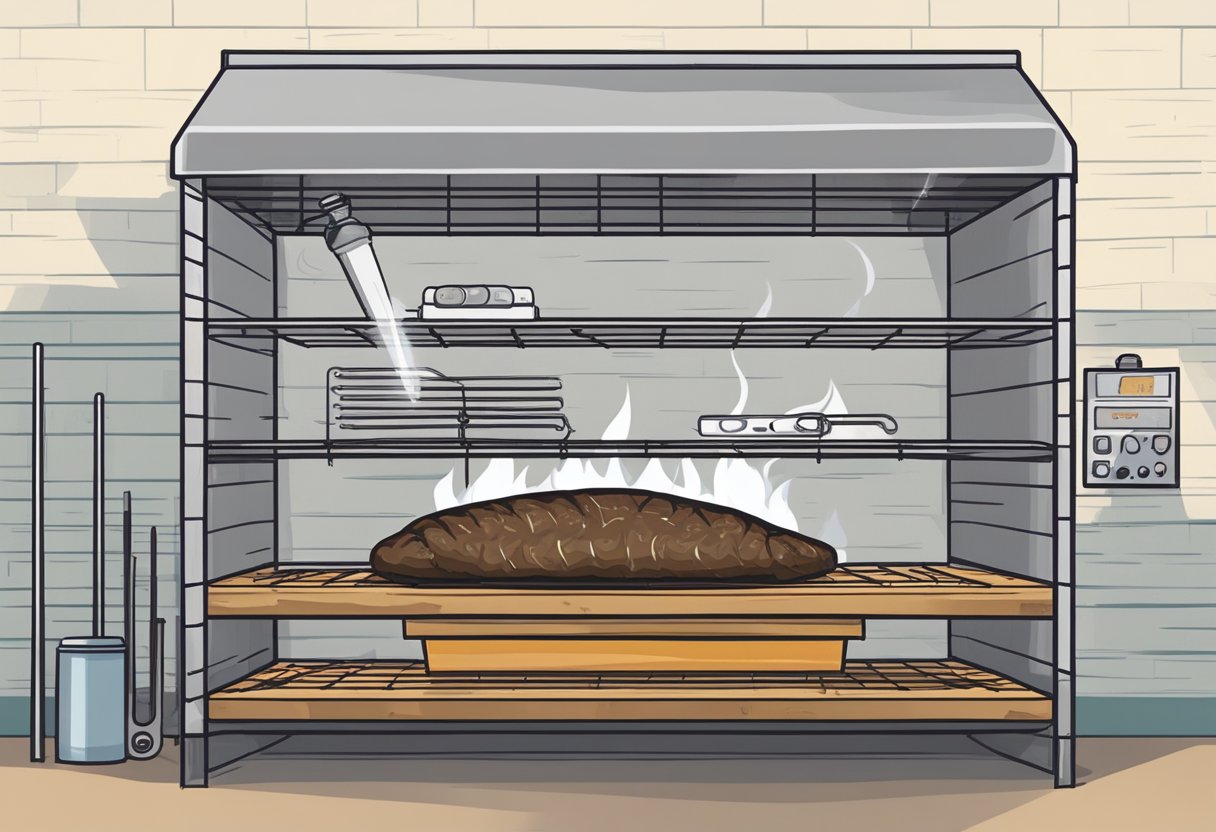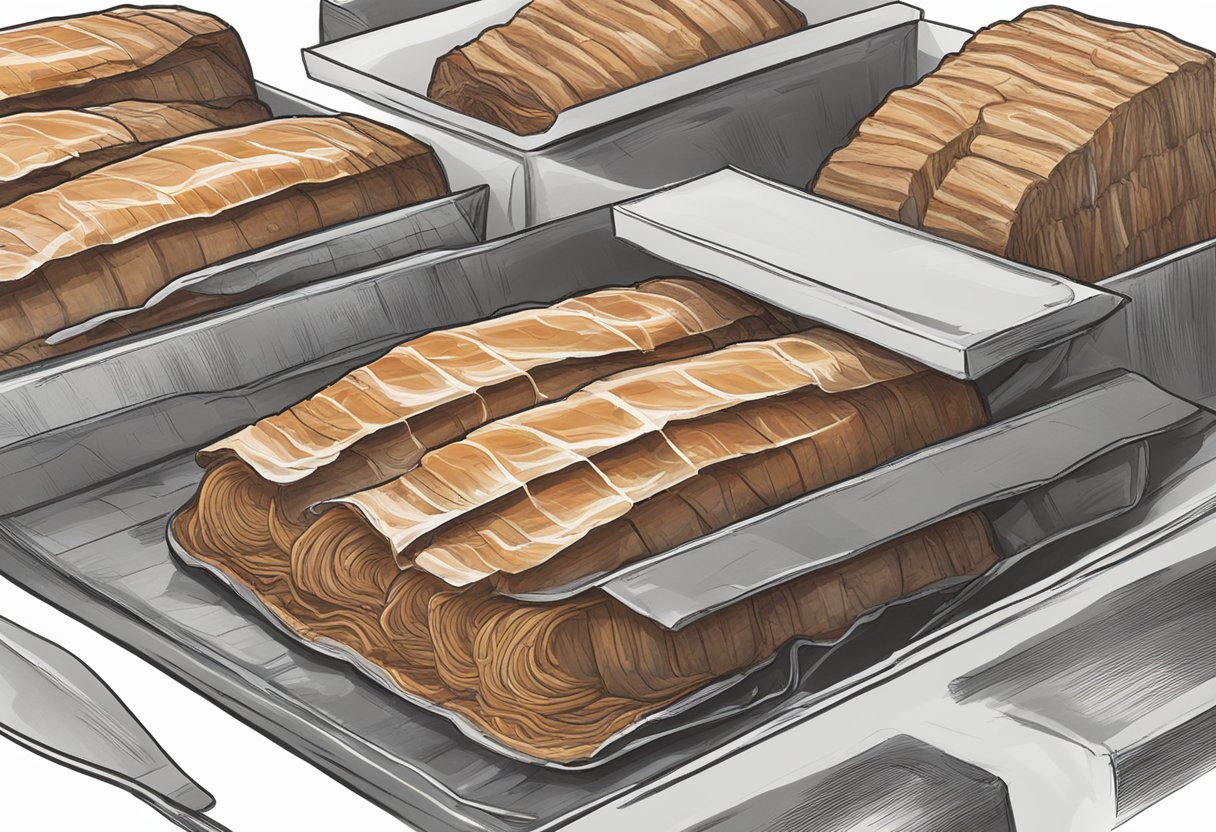When it comes to smoking brisket, one of the most debated topics among pitmasters is when to wrap the meat. Some swear by wrapping the brisket in foil or butcher paper after a certain amount of time, while others prefer to leave it unwrapped the entire cook. So, what’s the right answer? Well, it depends.

Understanding the smoking process and the behavior of brisket during the cook is crucial to determining when to wrap. Brisket is a tough cut of meat that requires low and slow cooking to break down the collagen and connective tissues. During the cook, the brisket will go through a phase known as “the stall,” where the internal temperature will plateau for several hours. This can be frustrating for many pitmasters, but it’s a natural part of the cooking process and helps to tenderize the meat.
Key Takeaways:
- The decision of when to wrap brisket depends on various factors, including personal preference, cooking method, and desired outcome.
- Understanding the behavior of brisket during the smoking process, including the stall, is crucial in determining when to wrap.
- Wrapping options, such as foil or butcher paper, can impact the flavor and texture of the brisket, and it’s essential to consider the pros and cons of each method before deciding.
Understanding Brisket and the Smoking Process

Beef brisket is a large cut of meat that comes from the lower chest of the cow. It is a tough cut of meat that requires low and slow cooking to break down the connective tissues and become tender. Smoking is one of the best ways to cook brisket and impart a smoky flavor to the meat.
The smoking process involves cooking the meat with smoke from burning wood or charcoal. The smoke not only adds flavor but also helps to cook the meat by slowly raising the internal temperature. Different types of wood can be used for smoking, each with its own unique flavor profile. Some common woods used for smoking brisket include hickory, mesquite, oak, and apple.
To achieve the best smoke flavor, it is important to understand the smoking process and how it affects the brisket. The smoke flavor comes from compounds in the smoke that are absorbed by the meat. The longer the meat is exposed to smoke, the stronger the smoke flavor will be. However, too much smoke can overpower the natural flavor of the meat.
When smoking brisket, it is important to maintain a consistent temperature and smoke level. This can be achieved by using a smoker with precise temperature control or by monitoring the temperature and smoke manually. The ideal smoking temperature for brisket is between 225°F and 250°F.
In summary, understanding the smoking process and how it affects brisket is crucial for achieving a delicious and tender final product. By using the right type of wood, maintaining a consistent temperature and smoke level, and cooking low and slow, you can create a mouth-watering brisket with a perfect balance of smoky flavor and natural beef taste.
The Stall and Its Impact

When smoking a brisket, there is a phenomenon known as “the stall” that can occur. The stall is a period during the cooking process where the internal temperature of the brisket plateaus or even decreases for several hours. This can be frustrating for many pitmasters, as it can delay the cooking process and make it difficult to predict when the brisket will be done.
The stall occurs because of evaporative cooling. As the brisket cooks, moisture is released from the meat and evaporates into the air. This evaporation cools the surface of the brisket, which can cause the internal temperature to plateau or even decrease. The stall typically occurs when the brisket reaches an internal temperature of around 160°F to 170°F.
The impact of the stall can be significant. Depending on the size of the brisket and the cooking temperature, the stall can last for several hours. This can delay the cooking process and make it difficult to predict when the brisket will be done. It can also lead to a dry and tough brisket if not managed properly.
To manage the stall, many pitmasters will wrap the brisket in foil or butcher paper. This can help to trap moisture and prevent evaporative cooling, which can help the brisket to continue cooking and reach its target temperature more quickly. However, wrapping the brisket can also affect the bark and smoke flavor, so it is important to weigh the pros and cons before deciding to wrap.
In summary, the stall is a common occurrence when smoking a brisket that can delay the cooking process and make it difficult to predict when the brisket will be done. Understanding the science behind the stall and how to manage it can help pitmasters to produce a tender and juicy brisket every time.
Role of Internal Temperature

When it comes to brisket, the internal temperature is one of the most important factors to consider when deciding when to wrap the meat. The internal temperature of the brisket is a good indicator of how much the meat has cooked and how tender it will be.
To monitor the internal temperature of the brisket, a meat thermometer or a probe thermometer can be used. These thermometers can be inserted into the thickest part of the meat to get an accurate reading.
The temperature at which the brisket should be wrapped will depend on the desired level of tenderness. For example, if a juicy and tender brisket is desired, it is recommended to wrap the meat when the internal temperature reaches around 160-170°F. This will help to retain moisture and prevent the meat from drying out.
On the other hand, if a more firm and chewy brisket is desired, it is recommended to wait until the internal temperature reaches around 180-190°F before wrapping. This will allow the meat to develop a firmer texture and a more pronounced smoke flavor.
It is important to note that temperature control is crucial when cooking brisket. The temperature of the smoker or grill should be kept within a consistent range throughout the cooking process to ensure that the brisket cooks evenly and to the desired level of doneness.
In summary, the internal temperature of the brisket plays a crucial role in determining when to wrap the meat. By monitoring the internal temperature with a meat thermometer or probe, the desired level of tenderness can be achieved. Temperature control is also important to ensure that the brisket cooks evenly and to the desired level of doneness.
Why Wrap Brisket
Wrapping brisket is a common technique used by pitmasters and home cooks alike. When done correctly, it can help to keep the brisket moist and tender, while preventing it from drying out.
One of the main reasons to wrap brisket is to help retain moisture. As the brisket cooks, it releases juices that can evaporate if left exposed to the air. Wrapping the brisket in foil or butcher paper can help to trap these juices and create a moist cooking environment.
Wrapping can also help to tenderize the brisket. As the brisket cooks, it can become tough and chewy if not cooked properly. Wrapping the brisket can help to break down the connective tissue and create a more tender final product.
Another benefit of wrapping brisket is that it can help to prevent the brisket from drying out. When the brisket is wrapped, it is protected from the direct heat of the smoker or grill, which can cause it to dry out. This can help to maintain the juiciness of the brisket and prevent it from becoming tough and dry.
Overall, wrapping brisket is a technique that can help to create a moist and tender final product. Whether you choose to wrap your brisket in foil or butcher paper, it can be a valuable tool in achieving the perfect brisket.
Wrapping Options and Their Effects
When it comes to wrapping brisket, there are several options available. Each option has its own unique effect on the meat. Here are some of the most common options for wrapping brisket:
Aluminum Foil
Wrapping brisket in aluminum foil is a popular option among pitmasters. It creates a tight seal around the meat, which helps to retain moisture and flavor. However, some argue that the foil can create a steaming effect, which can soften the bark and make it less crispy.
Butcher Paper
Butcher paper is another popular option for wrapping brisket. It allows the meat to breathe while still retaining moisture. The paper also helps to create a nice bark on the meat. Some pitmasters prefer pink butcher paper, which is unbleached and has a slightly different texture than regular butcher paper.
Parchment Paper
Parchment paper is a less common option for wrapping brisket, but it can be effective. It allows the meat to breathe and retains moisture, but it doesn’t create as much of a seal as aluminum foil or butcher paper.
When deciding which option to use, it’s important to consider the desired outcome. If you want a crispy bark, foil may not be the best option. If you want to retain moisture while still allowing the meat to breathe, butcher paper or parchment paper may be a better choice.
Overall, the key is to experiment with different wrapping options to find what works best for you and your brisket.
The Texas Crutch Method
The Texas Crutch Method is a popular technique used by many pitmasters to speed up the cooking process and prevent the brisket from overcooking. The method involves wrapping the brisket in heavy-duty aluminum foil during the cooking process to create a steamy environment that helps to tenderize the meat and speed up the cooking time.
The Texas Crutch Method is especially useful when cooking briskets that are larger than 12 pounds, as they tend to take longer to cook and can easily dry out if not properly monitored. Wrapping the brisket in foil helps to retain moisture and prevent the meat from drying out, resulting in a juicy and flavorful brisket.
To use the Texas Crutch Method, simply wrap the brisket tightly in heavy-duty aluminum foil when the internal temperature reaches around 160°F. This will help to speed up the cooking process and prevent the brisket from overcooking. Be sure to wrap the brisket tightly to prevent any steam from escaping, as this will help to create a moist and tender brisket.
While the Texas Crutch Method can help to speed up the cooking process and prevent the brisket from overcooking, it is important to note that it can also result in a softer bark and less smoke flavor. If you prefer a crispy bark and a stronger smoke flavor, you may want to consider skipping the Texas Crutch Method and cooking your brisket without wrapping it in foil.
Overall, the Texas Crutch Method is a great technique to use when cooking large briskets that require longer cooking times. It can help to speed up the cooking process and prevent the brisket from overcooking, resulting in a juicy and flavorful brisket that is sure to impress.
Impact on Flavor and Texture
When it comes to smoking brisket, the timing of when to wrap the meat can have a significant impact on its flavor and texture. Here, we will explore the effect of wrapping brisket on various aspects of the meat.
Flavor
Wrapping brisket can lead to a milder, less intense smoky flavor. This is because wrapping the meat in foil or butcher paper traps in moisture and prevents smoke from penetrating the meat. However, wrapping can also help the meat retain its natural juices, resulting in a more succulent and tender brisket.
Bark
The bark, or the outer layer of the brisket, can be affected by wrapping. When the brisket is wrapped, the bark can become softer and less crispy. This can be a positive or negative depending on personal preference. For those who prefer a softer bark, wrapping can be beneficial. However, for those who prefer a crispy bark, wrapping may not be the best option.
Texture
Wrapping brisket can lead to a more tender and juicy meat. This is because the moisture is trapped inside the wrap, which helps to break down the tough connective tissue in the meat. However, wrapping can also lead to a softer texture overall, which may not be desirable for everyone.
Smoky Flavor
As mentioned earlier, wrapping brisket can lead to a milder smoky flavor. This is because the smoke is trapped inside the wrap, preventing it from penetrating the meat. For those who prefer a stronger smoky flavor, not wrapping the brisket may be the better option.
Color and Appearance of the Bark
The color and appearance of the bark can also be affected by wrapping. When the brisket is wrapped, the bark can become darker and less visually appealing. However, this is not always the case and can depend on the type of wrap used.
Brisket Taste
Overall, wrapping brisket can have a significant impact on the taste and texture of the meat. While it may lead to a milder smoky flavor and softer bark, it can also result in a more tender and succulent brisket. Ultimately, the decision to wrap or not to wrap comes down to personal preference and experimentation.
The Role of Fat and Moisture
Fat and moisture play a critical role in determining when to wrap brisket. The fat content in brisket is an essential factor that affects the cooking process and the final result.
During the cooking process, the fat in the brisket slowly renders down, which helps to keep the meat moist and juicy. However, if the brisket is left unwrapped for too long, the fat can evaporate, leaving the meat dry and tough.
Moisture is another critical factor that affects the cooking process. When the brisket is wrapped, it traps moisture inside, which helps to keep the meat juicy. Wrapping the brisket also helps to prevent evaporation, which can cause the meat to dry out.
In general, wrapping the brisket when it reaches an internal temperature of around 160-170°F is recommended. At this point, the brisket has already undergone the majority of the cooking process, and the meat has started to break down and become tender.
Overall, the role of fat and moisture in determining when to wrap brisket is crucial. By keeping the meat moist and preventing evaporation, wrapping the brisket can help to produce a juicier, more tender final product.
Competition Barbecue Techniques
Competition barbecue is a serious business. Pitmasters spend countless hours perfecting their techniques to produce the best possible brisket. One of the most important techniques in competition barbecue is knowing when to wrap the brisket.
Competition pitmasters often wrap their brisket in foil or butcher paper to help retain moisture and create a mahogany-colored bark. The timing of when to wrap the brisket is crucial, as wrapping too early or too late can result in a less than desirable outcome.
The general rule of thumb for wrapping brisket in competition barbecue is to wrap once the meat has reached the desired color and smoke ring. This usually occurs around the 4-6 hour mark, but can vary depending on the pit and cooking temperature.
Some pitmasters prefer to wrap their brisket in foil to create a tighter seal and retain more moisture, while others opt for butcher paper to allow for more smoke penetration. It ultimately comes down to personal preference and the desired outcome.
It’s important to note that wrapping brisket too early can result in a lack of smoke penetration and a less developed bark, while wrapping too late can result in a dry and overcooked brisket.
In conclusion, competition barbecue techniques require a great deal of knowledge and skill, particularly when it comes to wrapping brisket. Pitmasters must carefully monitor their meat and make informed decisions on when to wrap to produce the best possible outcome.
Resting Period and Final Steps
After the brisket has been cooked to perfection, it is important to let it rest before slicing and serving. The resting period allows the juices to redistribute throughout the meat, resulting in a more tender and flavorful brisket.
Typically, the resting period should last for about 30 minutes to an hour. During this time, the brisket should be wrapped tightly in foil or butcher paper and placed in a cooler or warm oven to keep it at a consistent temperature.
Once the resting period is over, it’s time to slice the brisket. It’s important to slice against the grain to ensure maximum tenderness. This can be done by identifying the direction of the muscle fibers and slicing perpendicular to them.
In addition to slicing, there are a few final steps to take before serving. These include removing any excess fat and trimming the edges of the brisket to create a clean and even appearance.
Overall, the resting period and final steps are crucial components of the brisket cooking process. By following these steps, you can ensure that your brisket is not only delicious but also visually appealing.
Common Pitfalls and How to Avoid Them
When it comes to wrapping brisket, there are some common pitfalls that can ruin the final product. Here are some of the most common mistakes and how to avoid them:
Drying Out
One of the biggest concerns when wrapping brisket is the potential for it to dry out. This can happen if the meat is wrapped too tightly or if it is kept in the wrap for too long. To avoid this, make sure to wrap the brisket loosely and only keep it in the wrap until it reaches the desired level of tenderness.
Overcooking
Another common pitfall when wrapping brisket is overcooking. This can happen if the meat is left in the wrap for too long or if the temperature is too high. To avoid this, make sure to monitor the temperature of the meat and remove it from the wrap as soon as it reaches the desired level of tenderness.
Mushy Brisket
Wrapping brisket can also result in a mushy texture if it is not done properly. This can happen if the meat is wrapped too tightly or if it is not given enough time to rest before serving. To avoid this, make sure to wrap the brisket loosely and allow it to rest for at least 30 minutes before slicing and serving.
Boat Method
The boat method is a popular way to wrap brisket, but it can also lead to some of the pitfalls mentioned above. To avoid drying out or overcooking, make sure to wrap the brisket loosely and only keep it in the wrap until it reaches the desired level of tenderness.
Easy Method
The easy method of wrapping brisket involves wrapping it in foil or butcher paper and placing it in the oven or on the grill. While this method can be convenient, it can also lead to some of the pitfalls mentioned above. To avoid these issues, make sure to monitor the temperature of the meat and remove it from the wrap as soon as it reaches the desired level of tenderness.
Foolproof
To ensure a foolproof brisket, it is important to follow a few key steps. First, make sure to choose a high-quality cut of meat. Second, season the brisket well with a dry rub. Third, monitor the temperature of the meat throughout the cooking process. Finally, wrap the brisket loosely and only keep it in the wrap until it reaches the desired level of tenderness.
By avoiding these common pitfalls and following the steps outlined above, anyone can achieve a perfectly cooked and delicious brisket.
Follow us!!